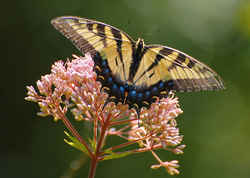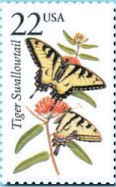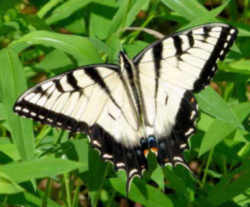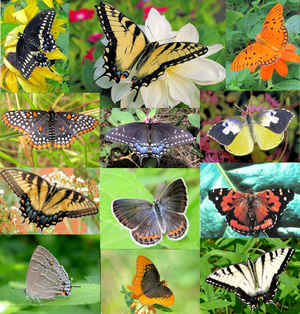
South Carolina Symbols
South Carolina State Butterfly
Eastern Tiger Swallowtail

(Pterourus Glaucus)
Adopted in 1994.
The Eastern Tiger Swallowtail, (Pterourus Glaucus,) was designated the official butterfly of the State of South Carolina
by Act No. 319, 1994. The first known painting was done in 1587 by John White, a commander in Sir Walter Raleigh's Expedition to the colonies. The
Garden Club of South Carolina has identified the Tiger Swallowtail of particular interest to South Carolinians because it serves as a pollinator in
orchards and gardens. It can be seen in deciduous woods, along streams, rivers and wooded swamps and in towns and cities throughout South Carolina.
On June 13, 1987, the US Postal Service issued a sheet of 50 different stamps commemorating American wildlife. State legislatures frequently pass laws that raise their share of controversy, depending on the issue and passion of the populace. Some legislation isn't particularly controversial, but honors some important aspect of state life. In 1994, the General Assembly of South Carolina proclaimed the eastern tiger swallowtail, (Papilio glaucus,) as the state's official butterfly in legislation known as Act 319 whereas, the tiger swallowtail, a large, yellow, black-striped butterfly, is one of the most familiar butterflies in North America and is one of the most common and conspicuous butterflies in the Eastern United States; and whereas, documentation of this butterfly in South Carolina dates back to 1725 when it was painted with a native shrub by an English painter, Mark Catesby; and
South Carolina State Butterfly:
Eastern Tiger Swallowtail

The eastern tiger swallowtail, (Papilio glaucus,) one of the most common and widely distributed swallowtail butterflies in the eastern United States, has a wingspan that can reach 5 inches. The males' bright yellow wings have four black bands on the front wings, and a long black tail on each hind wing, and are easily identified. The first rendering of this species was of an adult male, drawn in 1587 by John White, commander of Sir Walter Raleigh's third expedition to North America. Some females, particularly those in the North, are black, with some blue interlaced with black bands on the hind wings. These females superficially resemble the poisonous blue pipevine swallowtail, Battus philenor.
Characteristics of the Eastern Tiger Swallowtail
Color
P. glaucus has a black body with yellow stripes running laterally along both sides. The upper and lower wings are yellow accented with black bands (resembling tiger stripes). At the edges of all four wings are distinct black bands with yellow markings. The two lower wings have blue and orange spots near the tails (Klots,1979, 175).
Size
The Tiger Swallowtail is on average 4.0-5.0 inches in width, (Klots, 1979, 175) and 3.5-4.5 inches in height.
Food
The caterpillar feeds on trees: Wild Cherry, Tulip Tree, Birch, Poplar, and Ash (Klots, 1979, 175).
Life Cycle
- Two flights generally occur in the north, and three or four flights take place as far south as Florida.
- Male swallowtails fly at treetop level and descend to mate with lower-flying females.
- Females lay single, globular greenish-yellow eggs on the surface of leaves, and the young larvae that result are dark and resemble bird droppings.
- The two-inch-long mature larva or caterpillar is bright green and swollen in front, with false black and orange eyespots. These larvae spin a silk "mat" on the leaf, which curls the edges of the leaf somewhat.
- Larvae feed until they are full-grown, then develop into a dark brown or greenish brown caterpillar and descend the trunk of the tree and pupate on the ground, creating a dark stick-like chrysalis in which they overwinter.
- The pupa is light brown with a dark brown or black lateral stripe and dark brown dorsal band.
Habitat
The tiger swallowtail is widely distributed from New England west through the southern Great Lakes area (along Merriam's "transition life zone") through most of the Great Plains states and south to Texas and Florida. In the transition zone, the eastern tiger swallowtail is sympatric with the closely related Canadian tiger swallowtail, Papilio canadensis (until recently, considered a subspecies of P. glaucus).
South Carolina General Assembly
110th Session, 1993-1994
Bill 3635
(A319, R337, H3635)
AN ACT TO AMEND THE CODE OF LAWS OF SOUTH CAROLINA, 1976, BY ADDING SECTION 1-1-647 SO AS TO DESIGNATE THE TIGER SWALLOWTAIL AS THE OFFICIAL STATE
BUTTERFLY.
Whereas, the tiger swallowtail, a large, yellow, black-striped butterfly, is one of the most familiar butterflies in North America and is one of the
most common and conspicuous butterflies in the Eastern United States; and
Whereas, documentation of this butterfly in South Carolina dates back to 1725 when it was painted with a native shrub by an English painter, Mark Catesby;
and
Whereas, the Garden Club of South Carolina has identified the tiger swallowtail as of particular interest to South Carolinians because it can be seen
in deciduous woods, along streams, rivers, and wooded swamps, and in towns and cities throughout South Carolina. Now, therefore,
Be it enacted by the General Assembly of the State of South Carolina:
Official state butterfly
SECTION 1. The 1976 Code is amended by adding:
"Section 1-1-647. The tiger swallowtail is designated as the official state butterfly."
Time effective
SECTION 2. This act takes effect upon approval by the Governor.
Approved the 29th day of March, 1994.
South Carolina Law
The law designating the iger swallowtail as the official South Carolina state butterfly is found in the South Carolina Code of Laws, Title 1, Chapter 1, Article 9, Section 1-1-647.
Title 1 - Administration of the Government.
CHAPTER 1. GENERAL PROVISIONS.
ARTICLE 9. STATE EMBLEMS, PLEDGE TO STATE FLAG, OFFICIAL OBSERVANCES.
SECTION 1-1-647. Official State butterfly.
The tiger swallowtail is designated as the official state butterfly.
Taxonomic Hierarchy: Tiger Swallowtail
Kingdom: Animalia (Animals)
Phylum: Arthropoda (Arthropods)
Subphylum: Hexapoda (Hexapods)
Class: Insecta (Insects)
Order: Lepidoptera (Butterflies and Moths)
Superfamily: Papilionoidea (Butterflies and Skippers)
Family: Papilionidae (Swallowtails, Parnassians)
Subfamily: Papilioninae
Tribe: Papilionini (Fluted Swallowtails)
Genus: Papilio
Species; glaucus (Eastern Tiger Swallowtail)
Butterflies, and Bugs







